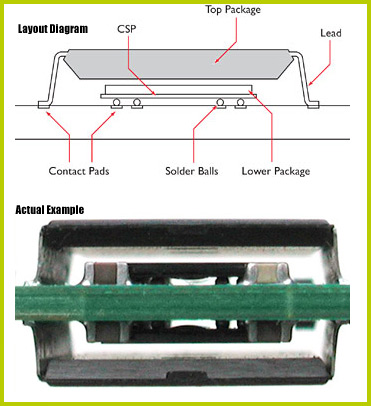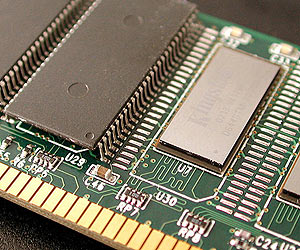EPOC Technology for Memory Modules
Kingston Technology are
a memory vendor you should be familiar with. If you have PC2700 DDR or PC1066
RDRAM chances are you've looked over a kingston memory module at least once in
your search for the best price. We've tested Kingston DDR and RDRAM on one or two
occassions and the quality level has always been pretty good.
A few days ago Kingston
announced a new memory packaging technology called "EPOC" - and no this isn't a
Matrix II spinoff.
EPOC stands for
Elevated Package Over CSP (Chip Scale Package) and what it describes is a
better way of making high-density DRAM modules. This isn't quite at the consumer level yet
since they are dealing Registered RAM at the moment, but given the
ease and robustness of the new manufacturing process it may be in our hands
very soon.
EPOC was developed with server memory in mind.
Servers are very crowded devices and there isn't much room in a 1U, 2U or even
3U rack mount system for many DIMM slots. DIMM slots are where the DRAM gets
clicked into place, and typically there are four on a motherboard.
With only
four slots to
populate, there is a natural barrier to how much memory can physically be
installed in any one system. Typically memory modules max out at 1GB - and since it
is very, very expensive to achieve this level of memory density using
16 individual TSOP-II chips (Thin-Small Outline Package), manufacturers use a few tricks.
One of the most widely used techniques is to stack lower density memory chips on
top of one another - usually to a height of two, but sometimes
three.

Making
memory with this process is not too complex, but it can be time consuming, and
cause delays if the solder joints are not perfect the first time around.
"Kingston
engineers worked closely with Payton Technology Inc., a Kingston subsidiary
dedicated to specialty chip packaging and testing, to develop this new
technology. "This joint Kingston-Payton project demonstrates the benefit of
Kingston's Express Wafer-to-Module program, which results in Kingston's faster
response to customer orders without jeopardizing quality or reliability," said
Daniel Hsu, general manager, Payton."

The 1.2" tall modules use a
3-dimensional memory module system where one chip essentially sits overtop of
another. Neither chip makes direct contact the one adjacent and this helps to
ensure adequate convection cooling. Were the TSOP and CSP chips to be in direct
contact with one another, the combined heat from each module could pose
problems.

The exposed DRAM chip is a
raised Thin-Small Outline Package (TSOP) memory type which is standard to most
of todays memory sticks. Below this chip lies a BGA mounted, and smaller, Chip
Scale Package (CSP) memory chip.
According to Kingston the idea
came about when they "first set out to eliminate the long lead-times required to
stack memory chips when using third-party stacking companies." "Kingston
engineers also set a design objective requiring the new technology to be as easy
to manufacture as standard modules." Because the two types of memory chip solve
the problem of memory density, and each make direct contact the PCB, the
manufacturing process is greatly simplified, and hence, more
reliable.

